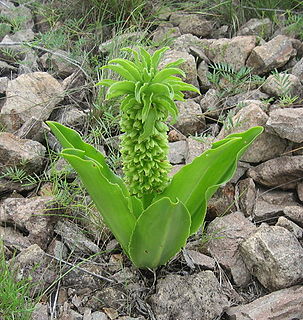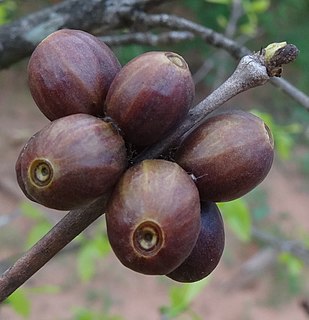
Xanthocercis is a tree genus in the family Fabaceae. Species include:

Eucomis is a genus of flowering plants in the family Asparagaceae, subfamily Scilloideae, native to southern Africa. Most species of this genus are commonly referred to as pineapple flowers or pineapple lilies. They are bulbous perennials with basal rosettes of leaves and stout stems covered in star-shaped flowers with a tuft of green bracts at the top, superficially resembling a pineapple – hence the common names.

Aloe excelsa is an arborescent aloe indigenous to southern Africa.
Pogonochloa is a genus of plants in the grass family. The only known species is Pogonochloa greenwayi, native to Zambia and Zimbabwe.
Andropterum is a genus of African plants in the grass family. There is only one known species, Andropterum stolzii, native to Zimbabwe, Zambia, Mozambique, Tanzania, Malawi and Burundi.
Nematopoa is a genus of African plants in the grass family. The only known species is Nematopoa longipes, native to Zambia and Zimbabwe.
Ampelocissus africana is a type of vine that is woody, or liana of the grape family, bearing edible fruit. It is native to habitats in, and around forested areas in Guinea, Ivory Coast, Nigeria, Cameroon, Chad, Central African Republic, Sudan, Kenya, Rwanda, Burundi, Tanzania, Malawi, Zambia, Mozambique, Zimbabwe and Botswana. It was originally described botanically in 1790 by João de Loureiro as Botria africanus, which is the basionym for its treatment here under Ampelocissus.
Summerhayesia is a genus of flowering plants from the orchid family, Orchidaceae. It has two known species, both native to tropical Africa.

Flora Zambesiaca is an ongoing botanical project aimed at achieving a full account of the flowering plants and ferns of the Zambezi River basin covering Zambia, Malawi, Mozambique, Zimbabwe, Botswana and the Caprivi Strip, and is published by the Royal Botanic Gardens, Kew. The work is published in parts or whole volumes as and when the relevant families are completed, and is currently (2012) over the halfway mark. Some 24 500 plant species have been described so far.

Psydrax livida is an Afrotropical shrub or small tree in the family Rubiaceae. It occurs in eastern and southern Africa, including Burundi, Kenya, the DRC, Tanzania, Malawi, Mozambique, Zambia, Zimbabwe, Angola, Botswana, northern Namibia and northern South Africa. It is deciduous or evergreen, and its green branches have an opposite and horizontal arrangement.

Alafia is a genus of lianas or climbing shrubs found in tropical Africa and Madagascar. The World Checklist of Selected Plant Families recognises 26 species:
Alafia barteri is a plant in the family Apocynaceae.
Alafia lucida is a plant in the family Apocynaceae.
Alafia multiflora is a plant in the family Apocynaceae.

Alafia caudata is a plant in the family Apocynaceae.
Alafia orientalis is a plant in the family Apocynaceae.

Tinnea is a genus of plants in the family Lamiaceae first described in 1867. It is native to sub-Saharan Africa.
- Tinnea aethiopicaKotschy ex Hook.f. - widespread from Mali to Somalia south to Mozambique; naturalized in Trinidad & Tobago
- Tinnea antiscorbuticaWelw. - Zaïre, Zambia, Angola
- Tinnea apiculataRobyns & Lebrun - eastern Africa from Rwanda to Mozambique
- Tinnea barbataVollesen - Swaziland, northern South Africa
- Tinnea barteriGürke - western Africa
- Tinnea benguellensisGürke - Angola
- Tinnea coeruleaGürke - Zaïre, Zambia, Angola
- Tinnea eriocalyxWelw. - Zaïre, Angola, Botswana, Namibia
- Tinnea galpiniiBriq. - Mozambique, Swaziland, South Africa
- Tinnea gossweileriRobyns & Lebrun - Angola
- Tinnea gracilisGürke - Tanzania to Zambia
- Tinnea mirabilis(Bullock) Vollesen - Tanzania
- Tinnea physalisE.A.Bruce - Tanzania
- Tinnea platyphyllaBriq. - Zaïre
- Tinnea rhodesianaS.Moore - South Africa, Namibia, Zimbabwe, Zambia, Angola, Mozambique
- Tinnea somalensisGürke ex Chiov. - Ethiopia
- Tinnea vesiculosaGürke - Tanzania, Malawi
- Tinnea vestitaBaker - Zimbabwe, Zambia, Angola, Botswana
- Tinnea zambesiacaBaker - Zimbabwe, Zambia, Malawi, Mozambique

Eucomis zambesiaca is a bulbous plant in the family Asparagaceae, subfamily Scilloideae, native to southern Africa, from Zimbabwe through Malawi to the Limpopo Province of South Africa. One of the smaller species in the genus, it has a rosette of leaves about 45 cm (18 in) across and white flowers in a spike to about 30 cm (12 in) tall.
Plants of the World Online is an online database published by the Royal Botanic Gardens, Kew. It was launched in March 2017 with the ultimate aim being "to enable users to access information on all the world's known seed-bearing plants by 2020". The initial focus was on tropical African Floras, particularly Flora Zambesiaca, Flora of West Tropical Africa and Flora of Tropical East Africa.

Coffea racemosa, or racemosa coffee, is a species of flowering plant in the family Rubiaceae. It has naturally low levels of caffeine, less than half of that found in Coffea arabica, and a quarter of that in Robusta coffee. It is endemic to the coastal forest belt between northern KwaZulu-Natal in South Africa and Zimbabwe, found in an area less than 150 km2 (58 sq mi) in size. It was widely cultivated by the Portuguese during the 1960-1970s in Mozambique, currently there are only two plantations at Ibo Island and in Hluhluwe, which remain.









